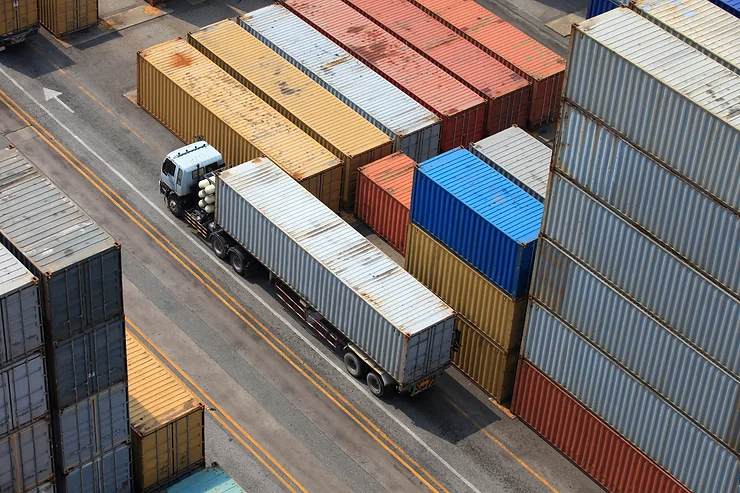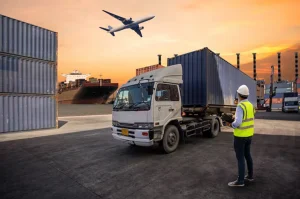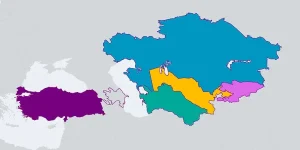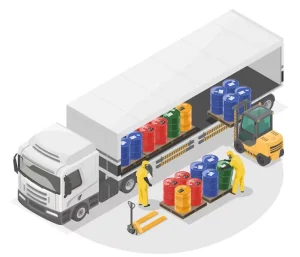What is Oversized Cargo Transportation?
Oversized cargo transportation, also known as heavy haul or over-dimensional freight transportation, refers to the movement of goods that exceed the standard size and weight limits allowed for typical freight. This type of cargo often includes machinery, equipment, construction materials, and other large or heavy items that cannot be transported using standard shipping methods.
Here are some key aspects of oversized cargo transportation:
-
Regulations and Permits: Transporting oversized cargo requires compliance with strict regulations and obtaining the necessary permits. These regulations vary by country and state, and they cover factors such as the dimensions, weight, and route of the cargo.
-
Specialized Equipment: To transport oversized cargo safely, specialized equipment is required. This includes heavy-duty trucks with multiple axles, extendable trailers, lowboy trailers, and other custom-designed vehicles to accommodate the size and weight of the cargo.
-
Route Planning: Planning the transportation route is critical. Special care is taken to choose roads and highways that can support the weight and dimensions of the cargo. Bridges, overpasses, and tight corners must be evaluated to ensure the cargo can pass without issues.
-
Safety Measures: Safety is a top priority in oversized cargo transportation. Drivers must be highly skilled and experienced, and additional safety measures such as escorts, pilot vehicles, and warning signs are often employed to ensure the safety of the cargo and other road users.
-
Load Securing: Properly securing the oversized cargo is essential to prevent shifting during transportation. This may involve using specialized tie-downs, chains, and other restraints to keep the cargo stable.
-
Timing and Scheduling: Transporting oversized cargo often requires careful scheduling to minimize disruption to traffic and communities. Transportation may occur during off-peak hours or on weekends to reduce congestion on the roads.
-
Costs: Oversized cargo transportation can be expensive due to the need for specialized equipment, permits, and escorts. The cost is often calculated based on factors such as distance, weight, dimensions, and route complexity.
Oversized Cargo Transportation: Pros & Cons
Oversized cargo transportation, like any logistical operation, comes with its own set of advantages and disadvantages. These can vary depending on the specific circumstances and requirements of each shipment. Here are some pros and cons of oversized cargo transportation:
Pros:
-
Ability to Move Large Equipment: Oversized cargo transportation enables the movement of large and heavy equipment, machinery, and materials that wouldn’t be feasible with standard shipping methods. This is crucial for industries such as construction, mining, and manufacturing.
-
Custom Solutions: Transportation companies specializing in oversized cargo often provide customized solutions to meet the unique needs of each shipment. This includes designing specialized trailers and equipment as well as route planning.
-
Market Expansion: For businesses, the ability to transport oversized cargo allows them to expand their market reach. They can take on projects in distant locations and serve a broader customer base.
-
Economic Impact: Oversized cargo transportation projects can have positive economic impacts on local communities, such as job creation and increased economic activity related to the project.
Cons:
-
Regulatory Challenges: Oversized cargo transportation is subject to strict regulations, including obtaining permits and complying with weight and size restrictions. Navigating these regulations can be time-consuming and costly.
-
High Costs: Transporting oversized cargo can be significantly more expensive than standard freight shipping. This includes the costs associated with specialized equipment, permits, escorts, and route planning.
-
Infrastructure Limitations: Roads, bridges, and other infrastructure may not be suitable for oversized cargo, necessitating route modifications or even construction to accommodate the transportation.
-
Safety Risks: Transporting oversized cargo carries inherent safety risks. Mishaps, accidents, or cargo shifts can have serious consequences for both the cargo and other road users.
Oversized Cargo Transportation to Central Asian Countries
Transporting oversized cargo to Central Asian countries involves unique challenges and considerations due to the region’s geography, infrastructure, regulations, and geopolitical factors. Central Asian countries, which include Kazakhstan, Uzbekistan, Turkmenistan, Kyrgyzstan, and Tajikistan, are landlocked and often have less developed transportation networks compared to more accessible regions.
Kazakhstan
Kazakhstan is the world’s largest landlocked country, and its vast terrain can present challenges for transporting large and heavy cargo. Here are some key factors to consider when transporting oversized cargo to Kazakhstan:
-
Regulations and Permits: Kazakhstan has strict regulations governing oversized cargo transportation. You will need to obtain the necessary permits and comply with weight and size restrictions.
-
Route Planning: Kazakhstan has a diverse landscape, including deserts, mountains, and remote areas. Ensure that the selected route can accommodate your cargo and that roads or railway tracks are suitable for transportation.
-
Customs and Border Crossings: Be prepared for customs procedures and border crossings, which can be time-consuming and require accurate documentation.
-
Infrastructure: The quality of infrastructure in Kazakhstan varies, with major cities having better transportation networks than remote regions. Assess the condition of roads, railways, and bridges to ensure they can handle your oversized cargo.
-
Transportation Modes: Decide on the most suitable transportation mode for your cargo. Options include trucking, railway transport, or a combination of both. The choice depends on factors like cargo size, weight, and the availability of transportation infrastructure.
-
Equipment and Expertise: Utilize specialized equipment such as heavy-duty trucks, trailers, cranes, and experienced operators who are familiar with oversized cargo transportation. Ensure that your cargo is properly secured for the journey.
-
Weather Conditions: Kazakhstan experiences extreme weather conditions, including hot summers and harsh winters. These conditions can affect transportation schedules and may require additional precautions and equipment.
-
Safety Considerations: Safety is paramount when transporting oversized cargo. Implement strict safety protocols and consider employing escorts or pilot vehicles to ensure the safety of the cargo and other road users.
Tajikistan
Transporting oversized cargo to Tajikistan, a landlocked country in Central Asia, presents specific challenges and considerations due to its mountainous terrain, regulatory requirements, and infrastructure limitations. Here are key factors to keep in mind when transporting oversized cargo to Tajikistan:
-
Regulations and Permits: Tajikistan has regulations governing oversized cargo transportation. You will need to obtain the necessary permits and comply with weight and size restrictions.
-
Route Planning: Plan the transportation route carefully, considering the mountainous terrain in Tajikistan. The road network can be challenging, especially in remote areas.
-
Customs and Border Crossings: Expect customs procedures and border crossings, which can be time-consuming and require accurate documentation.
-
Infrastructure: Tajikistan’s infrastructure, particularly in remote areas, may be limited and poorly maintained. Assess the condition of roads, bridges, and other infrastructure to ensure they can accommodate your oversized cargo.
-
Transportation Modes: Choose the most suitable transportation mode for your cargo. Options include trucking, railway transport, or a combination of both. Consider factors such as cargo size, weight, and the availability of transportation infrastructure.
-
Equipment and Expertise: Utilize specialized equipment such as heavy-duty trucks, trailers, cranes, and experienced operators who are familiar with oversized cargo transportation. Properly secure your cargo to ensure safety during transit.
-
Weather Conditions: Tajikistan experiences a wide range of weather conditions, including severe winters in mountainous areas. These conditions can impact transportation schedules and may require additional precautions and equipment.
-
Safety Considerations: Prioritize safety during oversized cargo transportation. Implement strict safety protocols and consider using escorts or pilot vehicles to ensure the safety of the cargo and other road users, especially on challenging mountain roads.
Uzbekistan
Transporting oversized cargo to Uzbekistan, a landlocked country in Central Asia, involves specific considerations due to the country’s geographical diversity, regulatory requirements, and infrastructure limitations. Here are key factors to keep in mind when transporting oversized cargo to Uzbekistan:
-
Regulations and Permits: Uzbekistan has regulations governing oversized cargo transportation. You will need to obtain the necessary permits and comply with weight and size restrictions. Ensure your cargo meets Uzbekistan’s legal requirements for dimensions and weight.
-
Route Planning: Plan the transportation route carefully, considering Uzbekistan’s diverse geography, including deserts, mountains, and plains.
-
Customs and Border Crossings: Be prepared for customs procedures and border crossings, which can be time-consuming and require accurate documentation.
-
Infrastructure: Uzbekistan’s infrastructure is relatively developed in urban areas but may be limited and less maintained in rural or remote regions. Evaluate the condition of the transportation infrastructure along the chosen route.
-
Transportation Modes: Select the most suitable transportation mode for your cargo. Options include trucking, railway transport, or a combination of both. Consider factors such as cargo size, weight, and the availability of transportation infrastructure.
-
Equipment and Expertise: Utilize specialized equipment such as heavy-duty trucks, trailers, cranes, and experienced operators who are familiar with oversized cargo transportation. Properly secure your cargo to ensure safety during transit.
-
Weather Conditions: Uzbekistan experiences a continental climate with hot summers and cold winters. Be prepared for weather-related challenges and ensure your cargo is protected from extreme temperatures and adverse weather conditions.
-
Safety Considerations: Safety is paramount during oversized cargo transportation. Implement strict safety protocols and consider using escorts or pilot vehicles to ensure the safety of the cargo and other road users, especially on challenging routes.
Turkmenistan
Transporting oversized cargo to Turkmenistan, a landlocked country in Central Asia, involves specific considerations due to its geographical characteristics, regulatory requirements, and infrastructure limitations. Here are key factors to keep in mind when transporting oversized cargo to Turkmenistan:
-
Regulations and Permits: Turkmenistan has regulations governing oversized cargo transportation. You will need to obtain the necessary permits and comply with weight and size restrictions.
-
Route Planning: Carefully plan the transportation route, considering Turkmenistan’s geography, which includes deserts, plains, and mountainous regions. Assess the condition of roads and bridges along the chosen route and ensure they can accommodate your oversized cargo. Specialized route surveys and assessments may be necessary.
-
Customs and Border Crossings: Be prepared for customs procedures and border crossings, which can be time-consuming and require accurate documentation.
-
Infrastructure: Turkmenistan’s infrastructure varies in quality, with urban areas generally having better transportation networks. In rural or remote regions, infrastructure may be limited and less maintained.
-
Transportation Modes: Choose the most suitable transportation mode for your cargo, whether it’s trucking, railway transport, or a combination of both. Consider factors such as cargo size, weight, and the availability of transportation infrastructure.
-
Equipment and Expertise: Utilize specialized equipment such as heavy-duty trucks, trailers, cranes, and experienced operators who are familiar with oversized cargo transportation. Properly secure your cargo to ensure safety during transit.
-
Weather Conditions: Turkmenistan experiences a continental climate with extreme temperatures. Be prepared for weather-related challenges and ensure your cargo is protected from extreme heat or cold during transit.
-
Safety Considerations: Safety is paramount during oversized cargo transportation. Implement strict safety protocols and consider using escorts or pilot vehicles to ensure the safety of the cargo and other road users, especially on challenging routes.
Kyrgyzstan
Transporting oversized cargo to Kyrgyzstan, a landlocked country in Central Asia with mountainous terrain, presents specific challenges and considerations. Here are key factors to keep in mind when transporting oversized cargo to Kyrgyzstan:
-
Regulations and Permits: Kyrgyzstan has regulations governing oversized cargo transportation. You must obtain the necessary permits and comply with weight and size restrictions.
-
Route Planning: Plan the transportation route carefully, taking into account Kyrgyzstan’s mountainous terrain. Assess the condition of roads and bridges along the chosen route to ensure they can accommodate your oversized cargo. Specialized route surveys and assessments may be necessary.
-
Customs and Border Crossings: Expect customs procedures and border crossings, which can be time-consuming and require accurate documentation.
-
Infrastructure: Infrastructure in Kyrgyzstan can vary in quality, with urban areas having better transportation networks. In rural or remote regions, infrastructure may be limited and less maintained. Evaluate the condition of the transportation infrastructure along your route.
-
Transportation Modes: Select the most suitable transportation mode for your cargo, whether it’s trucking, railway transport, or a combination of both. Consider factors such as cargo size, weight, and the availability of transportation infrastructure.
-
Equipment and Expertise: Utilize specialized equipment such as heavy-duty trucks, trailers, cranes, and experienced operators who are familiar with oversized cargo transportation. Properly secure your cargo to ensure safety during transit.
-
Weather Conditions: Kyrgyzstan experiences a continental climate with cold winters and hot summers. Be prepared for weather-related challenges and ensure your cargo is protected from extreme temperatures during transit.
-
Safety Considerations: Safety is paramount during oversized cargo transportation. Implement strict safety protocols and consider using escorts or pilot vehicles to ensure the safety of the cargo and other road users, especially on mountainous routes.
Oversized Cargo Transportation to Central Asia: Main routes
Transporting oversized cargo to Central Asia involves navigating complex logistics, regulations, and infrastructure challenges. Depending on the origin and destination of your cargo within Central Asia, local road transport may be necessary. This can involve traversing mountainous areas, deserts, and plains. Here are some of the main transportation routes and considerations for oversized cargo shipments to Central Asia:
1. China-Central Asia Route:
-
Route: Cargo can be shipped to China’s western regions and then transported overland into Central Asia through countries like Kazakhstan or Kyrgyzstan.
2. Caspian Sea Route:
-
Route: For cargo coming from Europe, the Caspian Sea offers a route to Kazakhstan and Turkmenistan. Cargo can be loaded onto ships and transported to Caspian Sea ports in Kazakhstan and Turkmenistan.
3. Silk Road Route:
-
Route: This historic route connects China with Central Asia and Europe, passing through several Central Asian countries. It’s a key trade corridor and offers multiple options for oversized cargo transportation.
4. Iran-Central Asia Route:
-
Route: This route involves transporting oversized cargo through Iran and then into Central Asia. The Bandar Abbas port in Iran is a common entry point for cargo destined for Central Asia.
Toptrans: Your Trusted Logistics Partner
At Toptrans, we specialize in international cargo transportation and have been at the forefront of the industry for over seven years. The professional logistics providers like Toptrans are ensuring the safe and efficient delivery of oversized cargo.
Experience in Handling Special Cargo
With extensive experience in transporting oversized cargo, Toptrans is well-equipped to handle the unique challenges posed by such shipments.
Toptrans’s Comprehensive Services
Toptrans offers a comprehensive range of services, including land, sea, air, and rail transportation. We handle various cargo types, including dangerous and military shipments.
The Diverse Fleet
Our diverse fleet of specialized vehicles and equipment ensures that we can handle oversized cargo of all sizes and specifications.
Geographical Coverage
Toptrans operates in various directions, serving European Union countries, Turkey, Central Asian States, Ukraine, and China, making us a preferred choice for partners seeking alternative transport solutions.








